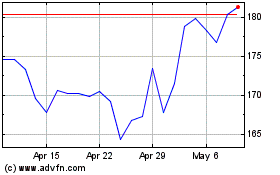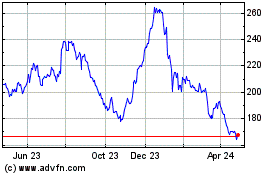Airline Profits to Reach Record Heights Before 2017 Descent
December 08 2016 - 5:20AM
Dow Jones News
GENEVA—The financial outlook for airlines is deteriorating with
collective industry profit set to peak this year as the industry's
leading trade group downgrades its financial outlook.
Overcapacity, rising fuel costs and political turmoil are
combining to spell an end to a five-year run of improving earnings,
the International Air Transport Association, representing more than
200 carriers, said Thursday.
Airlines are expected to deliver a combined record net profit
this year of $35.6 billion, IATA said. That represents an increase
from $35.3 billion last year, though a lower profit for 2016 than
IATA forecast six months ago when the trade group projected total
returns of $39.4 billion.
Industrywide profit should retreat next year and reach $29.8
billion, IATA said.
Profitability also is declining. Net profit margins are expected
to fall to an average of 4.1% next year from 5.1% this year.
"Even though we expect conditions to be more difficult, we see a
soft landing safely in profitable territory," said IATA Director
General Alexandre de Juniac. The industry that often has lost money
will have been in the black for eight years, he added.
The North American airline market reflects the trend. North
American carriers have propelled industrywide profit growth after a
period of consolidation in the U.S. allowed airlines there to
deliver record profits, aided also by a period of low fuel prices.
But profit for airlines in North America will fall slightly this
year to $20.3 billion from $21.5 billion in 2015. Profit will fall
further next year to $18.1 billion, IATA projects.
Airlines already are bracing for a tougher time ahead. Tim
Clark, president of Emirates Airline, the world's largest carrier
by traffic, Wednesday said he saw demand growth for air travel
slowing in the next few years.
The rapidly expanding Dubai-based carrier would use the
relatively slow period to improve internal operations rather than
chase expansion, he said. Plans to buy either Boeing Co. 787
Dreamliners or Airbus Group SE A350 long-range planes remain on the
agenda, Mr. Clark said at the Aviation Club in London, though with
less urgency given prevailing market uncertainties.
Among the industry headwinds are rising oil prices. The upward
movement got a boost through an agreement reached last week by the
Organization of the Petroleum Exporting Countries to curb oil
production, which has caused crude prices to surge. That darkens
the financial outlook for airlines for which fuel typically
represents one of their single highest costs.
"Unit costs are no longer falling faster than unit revenue,"
IATA chief economist Brian Pearce said, largely reflecting rising
fuel costs. IATA's forecast assumes no further rise in oil prices
beyond those triggered by the OPEC accord, he said.
The combined fuel bill for airlines is expected to rise to $129
billion next year from $124 billion in 2016.
Airlines also have had to contend with a series of other shocks,
including terrorist attacks at major airports in Brussels and
Istanbul.
Mr. de Juniac said governments needed to do more to boost
security after a year when airports in Brussels and Istanbul were
bombed. Intelligence collection needs to be improved, he said, and
shared more widely between countries and the air transport
industry.
Even so, the total number of people flying is set to rise to 3.8
billion passengers and further increase to 4 billion in 2017.
North American carriers this year and next are expected to
remain the top financial performers among all regions. Net profit
for European airlines this year should be flat at $7.5 billion
before retreating to $5.6 billion. Profit for Asia-Pacific airlines
will slip by $500 million this year to $7.3 billion and fall
another $1 billion in 2017.
The Middle East, home to rapidly expanding carrier such as
Emirates Airline and Qatar Airways, will see profit fall this year
to $900 million from $1.1 billion in 2015. Profits will retreat
further to $300 million next year, IATA forecasts.
Write to Robert Wall at robert.wall@wsj.com
(END) Dow Jones Newswires
December 08, 2016 05:05 ET (10:05 GMT)
Copyright (c) 2016 Dow Jones & Company, Inc.
Boeing (NYSE:BA)
Historical Stock Chart
From Mar 2024 to Apr 2024

Boeing (NYSE:BA)
Historical Stock Chart
From Apr 2023 to Apr 2024
